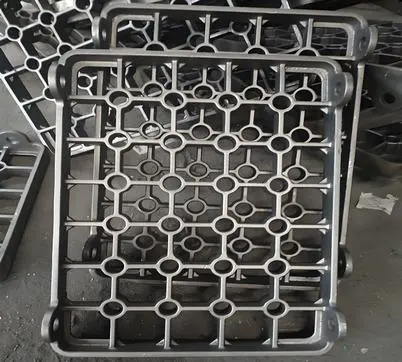Design Features of Base Trays for Optimal Cooling Control
Material Selection for Base Trays
The choice of material for base trays significantly influences their thermal properties and, consequently, the cooling rates during heat treatment. High-temperature alloys, such as heat-resistant stainless steels or nickel-based superalloys, are often preferred due to their excellent thermal stability and resistance to deformation at elevated temperatures. These materials maintain their structural integrity and dimensional accuracy throughout the heat treatment cycle, ensuring consistent support for the workpieces. Additionally, the thermal conductivity of the base tray material plays a crucial role in heat dissipation. Materials with lower thermal conductivity can help slow down the cooling process, which is beneficial for certain heat treatment operations that require gradual cooling to achieve specific microstructures or mechanical properties.
Surface Texture and Finish
The surface characteristics of base trays have a profound impact on the rate of heat transfer between the workpiece and the surrounding environment. A smooth, polished surface tends to promote faster cooling rates due to reduced thermal contact resistance. Conversely, textured or roughened surfaces can create air pockets that act as insulators, slowing down the cooling process. Some base trays feature specially designed patterns or grooves on their surface to control the flow of cooling gases or liquids, allowing for more uniform and controlled cooling across the workpiece. The choice of surface finish is often tailored to the specific requirements of the heat treatment process and the desired material properties of the final product.
Geometric Configurations
The shape and design of base trays are critical factors in determining cooling rates during heat treatment. Trays with open structures or perforations allow for better circulation of cooling media, promoting faster and more uniform cooling. On the other hand, solid trays with minimal surface area in contact with the workpiece can retard heat dissipation, resulting in slower cooling rates. Some advanced base tray designs incorporate cooling channels or fins to enhance heat transfer efficiency. The arrangement of multiple workpieces on a single tray also affects cooling dynamics, with spacing and orientation carefully considered to ensure consistent thermal treatment across all parts.
Impact of Base Trays on Cooling Uniformity and Precision
Thermal Mass Considerations
The thermal mass of base trays is a critical factor in determining the overall cooling behavior of heat-treated components. Trays with higher thermal mass act as heat sinks, absorbing and storing thermal energy from the workpieces. This characteristic can be advantageous in situations where gradual, controlled cooling is desired, as it helps to minimize thermal shock and reduce the risk of distortion or cracking in sensitive materials. However, excessive thermal mass can also lead to uneven cooling, particularly in cases where rapid quenching is required. Balancing the thermal mass of base trays with the specific cooling requirements of different heat treatment processes is essential for achieving optimal results across various industrial applications.
Cooling Media Interaction
Base trays play a significant role in how cooling media, such as air, gases, or quenching fluids, interact with the workpieces during the cooling phase of heat treatment. The design of base trays can influence the flow patterns and distribution of cooling media around the treated parts. For instance, trays with strategically placed openings or channels can direct the flow of cooling gases or liquids to ensure uniform heat extraction across the entire surface of the workpiece. This level of control is particularly important in processes that require precise cooling rates to achieve specific microstructural transformations or to prevent undesirable phase changes in the material.
Temperature Gradient Management
One of the key challenges in heat treatment processes is managing temperature gradients within the workpiece during cooling. Base trays can be designed to help mitigate these gradients, promoting more uniform cooling throughout the part. This is particularly important for large or complex-shaped components where uneven cooling can lead to residual stresses, distortion, or inconsistent material properties. Advanced base tray designs may incorporate zoned cooling features or variable thermal conductivity across different regions to address specific cooling requirements of different areas of the workpiece, ensuring more precise control over the final material properties and dimensional stability.
Innovations in Base Tray Technology for Enhanced Heat Treatment Control
Smart Base Trays with Integrated Sensors
The integration of sensors and smart technologies into base tray designs represents a significant advancement in heat treatment process control. These innovative trays are equipped with temperature sensors, strain gauges, and other monitoring devices that provide real-time data on the cooling conditions experienced by the workpieces. This information allows for dynamic adjustments to the cooling process, ensuring that the desired cooling rates are maintained throughout the heat treatment cycle. Smart base trays enable more precise control over material transformations, leading to improved consistency and quality in the final products. This technology is particularly valuable in industries with stringent quality requirements, such as aerospace and medical equipment manufacturing.
Additive Manufacturing for Customized Base Trays
Additive manufacturing technologies, such as 3D printing, are revolutionizing the design and production of base trays for specialized heat treatment applications. These advanced manufacturing techniques allow for the creation of complex geometries and internal structures that would be difficult or impossible to achieve through traditional manufacturing methods. Custom-designed base trays can incorporate optimized cooling channels, variable thickness sections, and tailored support structures to address the specific cooling requirements of different components. This level of customization enables manufacturers to fine-tune the cooling process for individual parts or batches, resulting in improved process efficiency and product quality.
Hybrid Materials and Coatings
The development of hybrid materials and advanced coatings for base trays is pushing the boundaries of heat treatment process control. These innovations combine the benefits of different materials to achieve optimal thermal performance and durability. For example, base trays may feature a core material with high thermal conductivity coated with a ceramic layer that provides insulation and wear resistance. Specialized coatings can also be applied to base trays to modify their surface properties, allowing for better control over heat transfer rates and interaction with cooling media. These advanced material solutions enable more precise manipulation of cooling rates, contributing to enhanced process control and product quality across various industrial applications.
In conclusion, base trays play a pivotal role in influencing cooling rates during heat treatment processes, significantly impacting the quality and properties of manufactured components across various industries. By carefully considering the design features, material selection, and innovative technologies associated with base trays, manufacturers can achieve unprecedented levels of control over cooling dynamics, resulting in superior product quality and consistency. As industries continue to demand higher performance materials and more precise manufacturing processes, the evolution of base tray technology will remain crucial in meeting these challenges. For more information on how advanced base tray solutions can enhance your heat treatment processes and improve product quality, please contact us at info@welongpost.com.




